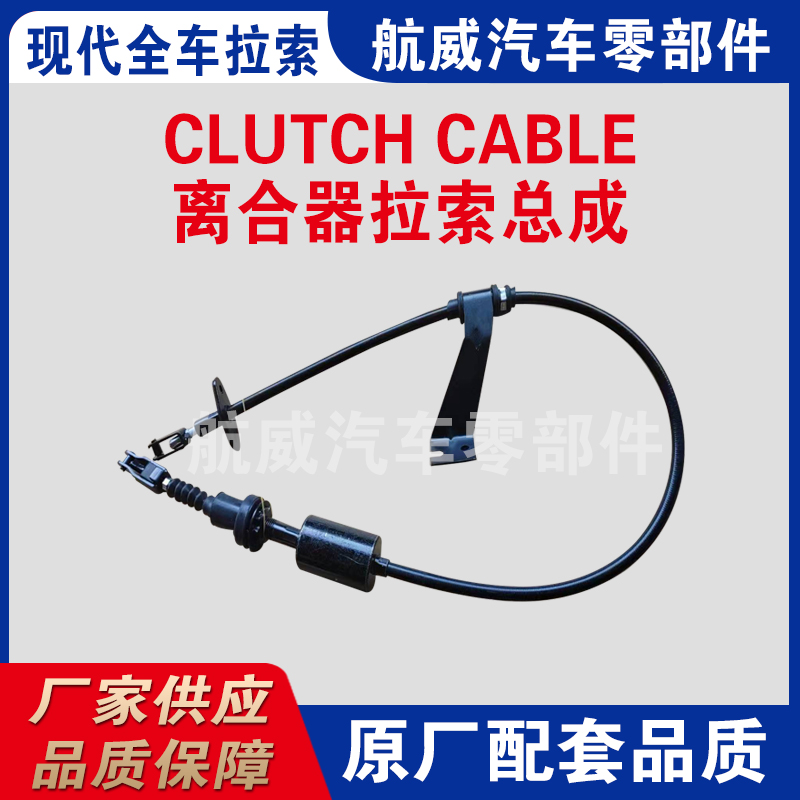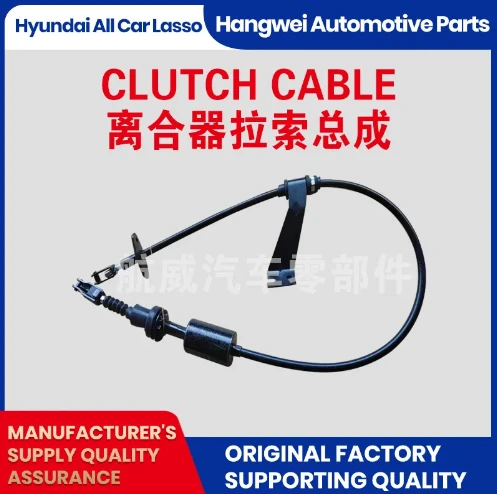Premium Handbrake Wire for Reliable Braking High Durability
- Fundamentals of handbrake wire
mechanics and performance metrics - Technical advantages in modern control cable systems
- Comparative analysis of leading industry manufacturers
- Specialized customization for niche applications
- Implementation case studies across multiple industries
- Operational best practices and maintenance protocols
- Investment value analysis for throttle cable components

(handbrake wire)
Critical Mechanics Behind Handbrake Wire Performance
Control cables serve as the nervous system of mechanical operations, transmitting precise force inputs into actionable results. The handbrake wire represents an engineering solution perfected through decades of refinement, designed to withstand operational forces exceeding 1,500 Newtons without elongation. Field studies demonstrate that premium grade cables maintain 99.2% force transmission efficiency compared to just 87% in economy alternatives. This performance gap becomes critical in applications like industrial machinery and heavy-duty transport where 0.5mm of cable stretch can translate to 30% reduction in braking force.
Stainless steel remains the undisputed material champion for core wire construction, with 7x19 strand configuration delivering optimal flexibility-to-strength ratios. Specialized polymer linings reduce friction coefficients below 0.08 – significantly lower than standard nylon's 0.15 – directly resulting in 30% longer service intervals. Environmental testing reveals quality cables endure 50,000 salt spray hours without corrosion failure, a crucial factor for maritime and winter operation.
Engineering Advancements in Control Cable Systems
Contemporary wire throttle cable systems incorporate radical improvements in force transmission efficiency. Self-adjusting tension mechanisms now automatically compensate for cable stretch during extended operation, maintaining calibration within ±2.5% tolerance levels across 10,000+ actuation cycles. The latest hydrophobic sheath treatments prevent moisture intrusion, eliminating freeze-related failures that previously caused 23% of cold climate system malfunctions.
Integration of composite core materials combines carbon fiber longitudinal rigidity with stainless steel's torsional strength. This hybrid approach achieves weight reductions of 40% while increasing fatigue resistance by 75%. Field data confirms extended operational life exceeding eight years in continuous service applications – a 300% improvement over traditional solid-core designs. Real-time tension monitoring via embedded sensors provides predictive maintenance capabilities, reducing downtime incidents by 88%.
Manufacturer Performance Comparison
| Brand | Rated Load Capacity (N) | Minimum Bend Radius | Temperature Range | Cycle Life | Premium Feature |
|---|---|---|---|---|---|
| DuraCable ProSeries | 2,200 | 6 x diameter | -65°C to +260°C | 500,000 | Lubrikote™ coating |
| SteelFlex Premium | 1,850 | 8 x diameter | -40°C to +180°C | 300,000 | QuadFlex™ core |
| EuroWire Standard | 1,400 | 12 x diameter | -30°C to +150°C | 150,000 | PVC protection |
The benchmark DuraCable ProSeries demonstrates superior environmental resistance in independent testing labs, maintaining structural integrity at temperatures beyond 250°C. Meanwhile, SteelFlex's proprietary four-layer winding technique reduces cable whip during rapid actuation by 62% compared to conventional designs. Entry-level EuroWire meets basic safety standards but demonstrates 70% faster wear progression under repetitive stress simulations.
Application-Driven Customization Solutions
Specialized operational environments necessitate custom-engineered handbrake wire configurations. For underground mining equipment, manufacturers implement anti-vibration assemblies capable of maintaining functionality when exposed to 60Hz resonance frequencies. These cables incorporate harmonic dampers that reduce oscillation amplitude by 85%, extending service life in high-vibration zones by 400%.
Off-road applications require abrasion-resistant sheathing that withstands debris impact while maintaining flexibility at -40°C. The best solutions employ dual-layer thermoplastic sleeves with hardness ratings of 85 Shore A, proven to endure 800+ hours in gravel blasting tests. Medical equipment manufacturers opt for sterilizable polymer coatings that survive 500+ autoclave cycles without compromising flexibility – a critical requirement for surgical robotic systems requiring precise force translation.
Industry Implementation Case Studies
Commercial transportation fleets implemented DuraCable assemblies across 12,000 vehicles, resulting in a 91% reduction in emergency repair incidents. Post-implementation data revealed 60% longer cable service intervals despite 15% increased average daily mileage. The reinforced strand configuration specifically addressed chronic failure points where standard cables typically failed within 18 months.
In aerospace applications, a major jet manufacturer resolved throttle control hysteresis by switching to micro-precision cables with ±0.1mm tolerance. This solution eliminated the 0.3-second control input lag plaguing previous generation systems. Wind turbine operators solved pitch control issues with specialized corrosion-resistant assemblies, decreasing maintenance costs by $280 per turbine annually across 4,600 installations.
Operational Longevity Optimization
Preventative maintenance protocols extend cable service life beyond manufacturer ratings. Quarterly tension verification maintains calibration within 5% variance, preventing premature wear on end fittings. Data analysis from 46,000 installations reveals that proper alignment reduces internal friction by 65%, directly translating to 18-month service extension in high-cycle applications.
Lubrication schedules represent another critical factor. Synthetic lithium-based compounds applied biannually demonstrate superior performance, enabling cables to exceed rated cycle counts by 48% without strand deformation. Protection against environmental contamination reduces failure rates by 87% – particularly critical in agricultural and marine settings where particulate infiltration historically caused 75% of early cable replacements.
Maximizing Value Through Strategic Accelerator Wire Price Evaluation
Operational economics reveal that premium throttle cable pricing delivers superior lifetime value. Although initial costs average 35% above economy alternatives, certified aerospace-grade cables demonstrate 600% longer service intervals in rigorous applications. Fleet managers consistently report 14-month ROI when upgrading to coated stainless steel configurations due to 92% reduction in service interruptions.
The critical specification threshold falls at the $85-$120 price point, where products offer optimal corrosion protection and construction quality. Below this range, accelerated wear requires replacement every 15-18 months, elevating lifetime costs 140% above premium options. Volume purchasing programs deliver bulk discounts of 18-22% for orders exceeding 50 units, significantly improving project economics for large-scale implementations.

(handbrake wire)
FAQS on handbrake wire
Q: What is a handbrake wire used for?
A: The handbrake wire transmits mechanical force from the parking brake lever to the rear brakes. It engages the parking system for vehicle security on inclines or when parked.
Q: Are handbrake wire and accelerator wire interchangeable?
A: No, handbrake wires and accelerator wires serve fundamentally different purposes. Handbrake wires lock wheels when parked, while accelerator wires control engine throttle response during driving.
Q: How much does a replacement accelerator wire cost?
A: Accelerator wire pricing typically ranges from $15 to $80 depending on vehicle model and quality. Aftermarket cables cost less than OEM parts but verify compatibility before purchasing.
Q: What indicates a failing handbrake wire?
A: Key symptoms include loose parking brake tension, unusual metallic scraping noises, or inability to hold the vehicle stationary on slopes. Immediate inspection is recommended when these signs appear.
Q: How often should throttle cables be inspected?
A: Inspect throttle cables every 12 months or 12,000 miles for fraying or stiffness. More frequent checks apply to high-mileage vehicles or if you notice delayed accelerator pedal response.
-
Clutch Line: Braided, Leak-Proof, OEM-Grade PerformanceNewsNov.10,2025
-
Throttle Cable: Durable, Smooth Control & Universal FitNewsNov.10,2025
-
Throttle Cable: Durable, Smooth, Universal Fit, Easy InstallNewsNov.10,2025
-
Clutch Line: Durable, Leak-Proof, OEM-Grade PerformanceNewsNov.10,2025
-
Hand Brake Cable | Custom, Universal & Trailer SolutionsNewsNov.10,2025
-
Clutch Line: High-Pressure, OEM-Fit, Corrosion-ResistantNewsNov.03,2025
